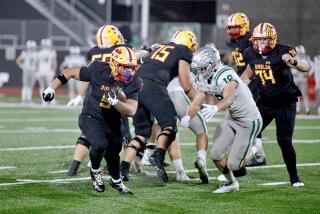No ifs, ands or BCS
- Share via
CHATTANOOGA, Tenn. — On a gorgeously clear and crisp evening, in a modern stadium flanked by picturesque mountains, a college football game was played Friday night to determine the national champion.
Montana defeated Furman, 13-6, before 12,698 at Finley Stadium, completing a four-game playoff run that left no doubt about which team is the best in Division I-AA, and which system is superior for determining a national champion.
The BCS so-called national championship game between unbeaten Miami and once-clobbered Nebraska at the Rose Bowl won’t be played until Jan. 3, and it might not even settle which team is best in Division I-A.
But there is no such debate in Division I-AA--and other small-college divisions in which the champion is decided by a playoff.
“Ain’t no doubt about it--we settle it on the field like everybody else should settle it on the field,” Montana Coach Joe Glenn said after the game. “Politics and money don’t enter into it. The championship feels pretty solid when you can’t buy it and can’t power it. You have to earn it.”
Montana won its second national title, its first since 1995. The Grizzlies finished 15-1, becoming what is believed to be the first college football team to play a 16-game schedule. “It was an NFL-type season,” said Montana defensive back Demetrious Williams, who played at Carson High and Harbor College.
The pros, cons and concept of the computer-driven BCS system have been debated since its inception in 1998. Controversy erupted earlier this month when Nebraska--embarrassed by Colorado, 62-36, Nov. 23 in its final regular-season game--still got its ticket punched to Pasadena.
That kind of outcome, along with the dollar-driven politics of bowl-game selection in general, has many fans suggesting the BCS just go ahead and drop its middle initial.
“The BCS is not a means of determining who is No. 1, it’s a means of making sure that the big schools, the big boys continue to receive their flow of revenue,” said Montana alumnus Rod MacKenzie, an attorney from Sacramento who travels to several Grizzly games each year.
“That’s really what it’s all about--the idea of the rich get richer.”
Dennis Poppe, the NCAA’s senior director of baseball and football championships, said member schools in each NCAA division determine how they want to conduct the postseason. A 16-team playoff is used in Division I-AA and Division II. A 28-team, five-round format is used in Division III.
The National Assn. of Intercollegiate Athletics (NAIA) uses a 16-team playoff.
But in Division I-A, schools play the regular season to earn slots in 25 bowl games. Poppe said the NCAA has broached the possibility of playoffs two or three times in the last 20 years.
“The decision-makers, the key stakeholders, those being the CEOs, presidents and chancellors of [Division I-A] institutions have not determined that’s the direction they want to go,” Poppe said.
Throw in bowl-game presidents, the six BCS commissioners, television networks and at least 50 coaches with incentive-laden contracts who can annually boast that they took their teams and alums to a bowl game, and it’s easy to see why there is no playoff system.
Should it choose, the NCAA could do a playoff on the major-college level.
“It’s not rocket science, it can be done,” Poppe said.
But not until the major players get on board.
“It’s the Southern Cals, it’s the UCLAs, it’s the Washingtons, the Notre Dames, the Alabamas, the Texases and the Nebraskas,” Poppe said. “When those schools determine that they want to have a championship, that’s when it will happen.”
Friday’s game was the 24th Division I-AA final. There was no subdivision in Division I until 1978, when a measure was passed at an NCAA convention allowing smaller schools with smaller budgets to compete among themselves.
Florida A&M;, Jackson State, Massachusetts and Nevada participated in the first four-team playoff, and Florida A&M; defeated Massachusetts for the title. The format was expanded to eight teams in 1981 and increased to 16 in 1986.
This season, 122 I-AA teams competed to play in the postseason and a chance to get to Chattanooga, which has hosted the final since 1997.
“It would be difficult going into a season not knowing that there is some kind of real [national] championship to win,” Furman defensive back Rodney Johnson said. “It makes it a lot easier to play harder with that goal in mind. We can win it all, we can get to the top, it’s all or nothing.”
One team from each of eight Division I-AA conferences--the Southern, Big Sky, Patriot, Ohio Valley, Gateway, Atlantic 10, Mid Eastern and Southland--receives an automatic berth in the playoffs, though they are not guaranteed one of the top eight seeds. Eight at-large teams are also selected for the tournament that usually begins the last week in November and concludes the third week in December. This year, the regular-season schedule and the start of the playoffs were pushed back a week after the Sept. 11 attacks.
Higher-seeded teams play at home in the first three rounds. The visitor arrives Thursday night or Friday morning for Saturday games. If a lower-seeded team wins, it does not assume the seeding position of the team it defeated.
Montana was ranked No. 1 at the end of the regular season, defending champion Georgia Southern was second and Furman, which shared the Southern Conference title with Georgia Southern, was third in the ESPN/USA Today poll and fourth in the Sports Network poll.
“If we had done it the way the BCS does, we would have been out ... and complaining about it,” said Tim Sorrells, Furman’s offensive coordinator.
Montana, which has an enrollment of more than 12,000, defeated Northwestern State, Sam Houston State and Northern Iowa to reach the final. Furman, which is located in Greenville, S.C., and has an enrollment of 2,500, beat Western Kentucky and Lehigh before ending Georgia Southern’s 39-game home winning streak with a 24-17 semifinal victory at Statesboro, Ga.
Mike Sewak, Georgia Southern’s new coach, said even in defeat, no one was pining for the BCS format.
“It never came up because in I-AA getting to the playoffs is the main goal, and once you get in you hold your own destiny,” said Sewak, who was Georgia Southern’s offensive coordinator before taking over for Paul Johnson after the loss to Furman. Johnson left to become coach at Navy.
The playoff system is not without critics. Like so many Division I-A presidents, Sorrells, the Furman assistant, questions whether a 15-or 16-game season serves the needs of student-athletes, especially when later playoff rounds occur during final exams.
“I’m not sure you really have the kids’ best effort either way,” he said. “It can create friction between the academic realm and the athletic realm at your school.”
Players disagree. “We haven’t missed a bit of school,” Furman offensive lineman Steven Rain said. “We scheduled practice around exams and had a few night practices. It’s really no big deal.”
Montana players were in the midst of finals when they left Missoula for their 2,000-mile trip here. Some players took exams early, others took them under faculty supervision on the plane or at the hotel. But that kind of scenario is not exclusive to football. Stanford’s baseball players handled the same situation in each of the last two College World Series.
“If you’re a good program and you have a good rapport with professors in the school, it shouldn’t be a problem,” said Montana running back Yohance Humphery, who rushed for 146 yards and a touchdown in 30 carries and finished the season with 2,105 yards.
Like almost all of the participants here, Glenn said he will be watching the Rose Bowl when Miami and Nebraska square off in 12 days.
But he won’t be referring to it as a championship game.
“If they want a real champion, they ought to follow this lead,” Glenn said. “Until they do, there will always be something flawed about the system.”
(BEGIN TEXT OF INFOBOX / INFOGRAPHIC)
Division I-AA Playoffs
First Round
Lehigh 27, Hofstra 24, 2 OT
Furman 24, W. Kentucky 20
Georgia Southern 60, Florida A&M; 35
Appalachian St. 40, William & Mary 27
Northern Iowa 49, Eastern Illinois 43
Montana 28, Northwestern State 19
Sam Houston St. 34, N. Arizona 31
Maine 14, McNeese State 10
*
Quarterfinals
Furman 34, Lehigh 17
Georgia Southern 38, Appalachian State 24
Montana 49, Sam Houston State 24
Northern Iowa 56, Maine 28
*
Semifinals
Furman 24, Georgia Southern 17
Montana 38, Northern Iowa 0
*
Championship
Montana 13, Furman 6
More to Read
Go beyond the scoreboard
Get the latest on L.A.'s teams in the daily Sports Report newsletter.
You may occasionally receive promotional content from the Los Angeles Times.











